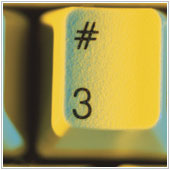 It’s a sure thing that if you say ‘social media’, the vast majority of people will think of either Facebook or Twitter. These are two of the largest networks that are used, with users often having accounts with both. Because of this, it’s not uncommon to see a trend develop on one network and expand to the others. One of the more common trends is the use of the hashtag (#). Do you know what it’s for though?
It’s a sure thing that if you say ‘social media’, the vast majority of people will think of either Facebook or Twitter. These are two of the largest networks that are used, with users often having accounts with both. Because of this, it’s not uncommon to see a trend develop on one network and expand to the others. One of the more common trends is the use of the hashtag (#). Do you know what it’s for though?
The hashtag (#), commonly referred to on telephone systems as the pound key, is a character first used by users of the popular social network Twitter. According to the help forum on Twitter, “It is used to mark keywords or topics in a Tweet. It was created organically by Twitter users as a way to categorize messages.”
Look at nearly any Twitter message and there will usually be hashtags attached. If you were to search for the term e.g., #Cloudbackup on Twitter, you would get a list of all tweets that have mentioned the above example. When Twitter talks about a ‘trending topic’ it means a subject that has become popular.
This way of categorization has become so popular amongst Twitter users that it’s starting to spill over onto the other networks. Instagram for instance has given members the ability to add hashtags to pictures, so that they can be added to groups which can subsequently be searched for. Even Google has gotten in on the act, with Google+ and YouTube both supporting this system.
With Facebook, the hashtag has come to give context to a status. You’ve probably seen some status updates such as: I love Mondays #sarcasm #bored. This should be read with a sarcastic and slightly bored tone.
Because of the usefulness of the hashtag, some users have become overzealous in their use. Reading a Tweet that says ‘#Friday is #awesome, here comes a #fun #weekend.’ just looks unprofessional and could put off followers.
While effective, there are some basic rules you should follow to help get the most out of your hashtags. Here’s four.
- No long hashtags. Hashtags are meant to be short and associated with one word. Don’t make the mistake of adding more than about two words together, as the likelihood of users finding the tag will decrease. e.g., #Cloudservicesareawesome should be avoided, use #cloudservices instead.
- Minimize their use. It can be tempting to hashtag every keyword in messages, however makes them look weird, while decreasing their readability. It is a good idea to limit use to one or two per message.
- The hashtag is special. Don’t use it for everyday words. Instead use it for product names, or a special part of the announcement. Remember that you don’t have to use hashtags in every message. Check out Samsung Mobile’s Twitter feed to see a good example of proper use.
- Use a unique hashtag. If you can, try to use a unique hashtag, something that followers will be able to associate and relate to you. The key here is that when it’s used, the user is referred to you, and only you. Do a quick search on Twitter for the hashtag you would like to use, to ensure it’s not taken. Many companies will shorten their tag to initials or a shorter term, which is perfectly acceptable.
Hashtags, when used correctly, can be a great way to build brand identity and increase social media presence. If you are looking for a social media plan, please contact us today to see how we can #expandbrands.

You must be logged in to post a comment.